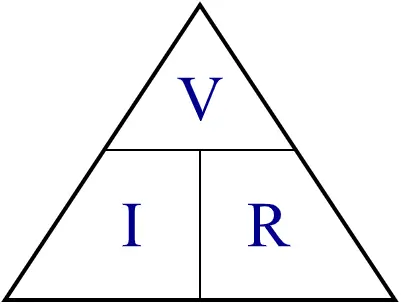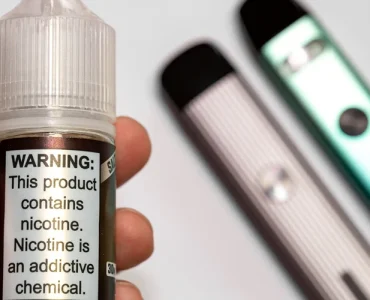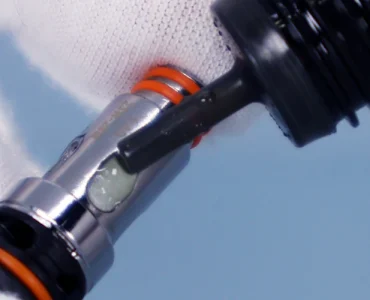Before you start building your own coils to put into your vape tank, you should know Ohm’s law. Whether you’re using a regulated mod or a mechanical mod, Ohm’s law gives you essential information about the limits of your build that will help keep your vaping experience a safe one.
Ohm’s law is essential to vaping because it determines the amount of amperage and wattage that your build will output which in turn determines if your build resistance is within safe limits for your battery. When these limits aren’t understood or respected is when batteries can explode. You should also have a firm understanding of battery safety before attempting to build your own coil.
In this guide you’ll learn how to calculate Ohm’s law for safe vaping using a set of easy to remember formulas. If math isn’t your thing, you can always use a calculator like Steam Engine to do the calculations for you. However, it’s always a good thing to know these formulas off hand for quick reference.
Take a few minutes reading this guide and you’ll be able to quickly figure out the voltage, current, resistance and wattage of any vaping circuit.
How to Calculate Ohm’s Law For Safe Vaping
Ohm’s law uses three essential elements for calculations: voltage, current, and resistance. These are typically depicted in a triangle with V, I & R. If you know two of the three, you can find out the third:

V: Voltage. This is the voltage of your battery. When fully charged, a single battery will have 4.2V. As the battery is discharged, the voltage will drop. It’s helpful to think of voltage as “electrical pressure”. In an electrical circuit such as your vape, voltage would be like the water pressure in a hose. High pressure can provide more flow than low pressure. The higher the voltage, the higher the potential amperage.
I: Current. This is the amperage output from your battery to your coil. Different batteries have different amperage ratings that they can safely output so it’s essential to know how to calculate current. Using the hose analogy, if voltage is water pressure then amperage is the actual amount of water (current) flowing through the hose.
R: Resistance. This is the resistance of your coil in ohms. A lower resistance coil will draw higher current (higher amperage) from your battery. This makes calculating resistance essential for building within the safe amperage limits of your battery.
If we use the hose analogy again, resistance would be the size of the hose. A wider hose means less resistance for the water (current) to pass through and so more water (current) can flow at one time through the hose. A narrower hose means that less water (current) can flow through the hose.
High resistance builds (high ohm coils) require less wattage and less current than lower ohm builds to achieve the same voltage. For example, a 1.0ohm coil only needs 14W & 3.7 amps to achieve a voltage of 3.7V. But a 0.20ohm coil needs 68.5W & 18.50 amps to achieve the same voltage of 3.7V. A lower ohm build will in turn lead to shorter battery life.
Now that you have a solid understanding of the components that make up an electrical circuit, like your vape, we can move on to the nitty gritty of the actual calculations.
How to Calculate Current (Amperage)
To calculate the current or amperage draw from your battery through your coil (resistance), we can refer to the triangle. Here we see that: I is equal to V divided by R:
I = V ÷ R
In other words, Current = Voltage ÷ Ohms
How to Calculate Current (Amperage) for a Single Battery Mechanical Mod
Voltage in this case will be the voltage of your battery. A single, freshly charged battery will have 4.2V when fully charged. If you’re using a coil with a resistance of 0.25ohm then:
I = V ÷ R
4.2V ÷ 0.25ohm = 16.80A
This build will draw 16.80 amps from your battery through the coil. This means that you’ll want to be using a battery that is rated for at least 20A to stay within safe limits. Keep in mind that as the battery depletes, the voltage will drop and this will pull less current through your coil. In turn, this will lead to a “softer” hit as the battery dies.
How to Calculate Current (Amperage) for a Parallel Mechanical Mod
If you’re using a mechanical mod with two batteries in a parallel configuration then the voltage remains 4.2V but the amperage is split between both batteries. This would mean that this same build (0.25ohm) would draw just half the current per battery:
I = V ÷ R
4.2V ÷ 0.25ohm = 16.80A
16.80 ÷ 2 = 8.4A per battery
How to Calculate Current (Amperage) for a Series Mechanical Mod
But what if you’re using a mechanical mod with two batteries in a series configuration? In this case you would double the voltage from 4.2V to 8.4V. This also doubles the amperage output per battery:
I = V ÷ R
8.4V ÷ 0.25ohm = 33.60A per battery
This build of 0.25ohm is not safe for use with series mechanical mods because it will pull 33.60 amps from each battery. Most batteries are only rated to 20A or 25A. A much safer build for a series mechanical mod would be 0.5ohms:
8.4V ÷ 0.5ohms = 16.80A per battery
How to Calculate Power (Wattage)
This formula isn’t a part of the triangle but it’s still easy enough to calculate. To calculate power or wattage we use the following formula:
P = V X I
Power = Voltage X Current
How to Calculate Power (Wattage) for a Single Battery Mechanical Mod
Using our example from earlier,we have a freshly charged battery with 4.2V. If it’s being used with a build that comes out to 0.25ohm then that build is drawing 16.80A of current. Plugging this into the formula above gives us:
P = V X I
4.2V X 16.80A = 70.6W
This build would output 70.6W of power.
How to Calculate Power (Wattage) for a Parallel Mechanical Mod
Calculating the wattage on a parallel mechanical mod is done the same as for a single battery mechanical mod. So again, we have two freshly charged batteries at 4.2V each. If these are being used with a build that comes out to 0.25ohm then this build is drawing 16.80A of current. The formula gives us:
P = V X I
4.2V X 16.80A = 70.6W
This build would output 70.6W of power on a parallel mechanical mod.
How to Calculate Power (Wattage) for a Series Mechanical Mod
Calculating the wattage for a series mechanical mod requires that you double the voltage. So with two freshly charged batteries at 4.2V each, that gives us 8.4V. If these are being used with a build that comes out to 0.50ohm (so that we’re in the safe limits of the batteries) we are drawing 16.80A of current. The formula gives us:
P = V X I
8.4V X 16.80A = 141.10W
This build would output 141.10W of power on a series mechanical mod. That’s a hot vape!
How to Calculate Resistance (Ohms)
The formula for calculating resistance can really come in handy. It’s especially useful if you want to figure out the lowest safe resistance for your battery’s current rating. If we look at the triangle we see that: R is equal to V divided by I:
R = V ÷ I
Resistance = Voltage ÷ Current
Batteries are commonly rated up to 20A. We’re going to calculate the lowest safe resistance when using a single battery mechanical mod, when using a parallel battery mechanical mod, and when using a series mechanical mod.
How to Calculate Resistance (Ohms) for a Single Battery Mechanical Mod
We’ll again use 4.2V for the voltage of a freshly charged battery. If this battery has a 20A current rating then:
R = V ÷ I
4.2V ÷ 20A = 0.21ohm
The lowest safe resistance for this battery would be a single coil with a resistance of 0.21ohm. If using dual coils, you would multiply this number by two in order to get the safe coil resistance for this battery:
0.21ohm X 2 = 0.42ohm
We do this because the resistance gets halved when you build with dual coils. This means that if you used two 0.21ohm coils it would come out to a final resistance of 0.105ohm which is definitely not safe for a battery rated at 20A.
Using two 0.42ohm coils would come out to 0.21ohm, within the safe limits of a battery rated at 20A.
Keep in mind, you might want to calculate using a lower discharge rating than your battery maximum, just to give you some wiggle room. Instead of calculating using 20 amps, using 18 amps or 19amps will give you a bit of a safety cushion.
How to Calculate Resistance (Ohms) for a Parallel Mechanical Mod
If you’re using a parallel mechanical mod then, as mentioned earlier, the amperage is split between both batteries. To calculate the lowest safe coil resistance, we add the current rating of the two batteries together and then use the same formula.
Note: you should always use two of the same battery in any dual battery mechanical mod.
The voltage remains 4.2V for a parallel mechanical mod using freshly charged batteries. If each battery is rated for 20A, then we can calculate the lowest safe resistance like so:
Add the current rating of both batteries:
20A + 20A = 40A
Then use the formula to calculate resistance:
R = V ÷ I
4.2V ÷ 40A = 0.105ohm
For a parallel mechanical mod with dual batteries, each rated at 20A, the lowest safe resistance is 0.11ohm. But to ensure that you remain safe, build a bit higher; 0.12ohm would be better to ensure that you’re vaping safely within the limits of your batteries and not stressing them.
NOTE: A single coil with a resistance of at least 0.11ohm is safe for the build above. But If using dual coils, each coil must have a resistance of at least 0.22ohm. This is because a dual coil build using two coils that each have a resistance of 0.22ohm will come out to 0.11ohm.
How to Calculate Resistance (Ohms) for a Series Mechanical Mod
When using a series mechanical mod, the voltage is doubled. With two freshly charged batteries you’ll have a voltage of 8.4V. If each battery is rated for 20A then we can calculate the lowest safe resistance like so:
R = V ÷ I
8.4V ÷ 20A = 0.42ohm
For a series mechanical mod with dual batteries, each rated at 20A, the lowest safe resistance is 0.42ohm. To ensure that you remain safe though, we suggest calculating using a lower amperage rating for your batteries. Instead of calculating using 20A, use 18A instead.
NOTE: A single coil with a resistance of at least 0.42ohm is safe for the build above. But If using dual coils, each coil must have a resistance of at least 0.84ohm. This is because a dual coil build using two coils that each have a resistance of 0.84ohm will come out to 0.42ohm.
How to Calculate Voltage
Less important, but still useful to know is how to calculate the voltage of your vape circuit. Taking a look at the triangle we can see that:
V = I X R
Voltage = Current X Resistance
This calculation remains the same regardless of if you’re using a single battery mechanical mod, parallel mechanical mod or series mechanical mod.
If we use the numbers from the previous section on calculating resistance:
V = I X R
20A X 0.21ohm = 4.2V
Calculating voltage is a piece of cake!
Wrapping up
Now that you know how to calculate Ohm’s Law you’re well on your way to safe vaping. A vape can be a dangerous device if not treated with care and respect so knowing how to calculate Ohm’s Law will prove very useful. Also, always make sure that you practice proper battery safety and stay well within the safe limits of your battery amperage rating.
Frequently Asked Questions
Why is Ohm’s Law important?
Ohm’s law is essential to vaping because it determines the amount of amperage and wattage that your build will output which in turn determines if your build resistance is within safe limits for your battery. When these limits aren’t understood or respected is when batteries can explode.
How to use Ohm’s Law
There are a number of situations where Ohm’s Law is essential:
- To calculate the amperage that your build is outputting. You need to know that your battery can safely handle the amperage that your build is drawing.
- To calculate the wattage that your build is outputting so that you can tweak it to deliver the power and warmth that you want from your vape.
- To figure out the lowest safe resistance that your battery can handle. You need to know the lowest ohm coil you can safely build.
What wattage is best for vaping?
There is no ‘best’ wattage to vape at because it all depends on the resistance of your coil. A lower resistance coil will require more wattage than a higher resistance coil to achieve the same vape. It really depends on how hot you like your vapor to be.
What is the best ohms for vaping?
The best ohms for vaping depends on how you like to vape. Lower resistance builds (like those less than 0.5ohm) will require more wattage and this generally produces a hotter, more intense vape. Builds over 1.0ohm will require less wattage and will deliver a less intense vape.










Thanks for your supporting. It’s help me use safely. Oh I have a question. I have used a box mod (it can change W) so I set it about 3.4v and use 0.19 ohm from coil. My CDR’ battery is 20A. Is it safe for me?
Yes, with that setup it will be drawing about 18A so it’s perfectly fine!
I have a littlefoot mech single battery and the battery I’m using is an LG 18650 HG2 20A continuous what would safe ohm’s be for a dual coil build? Your help is appreciated thank you
You’ll want to build at 0.23Ω or higher for that battery. At 0.23Ω with a fully charged battery (4.2V), you’ll be drawing 18A from the battery which gives you some wiggle room for safety.
This means that for a dual coil build, you’ll want to use two coils that each have a resistance of 0.46Ω. When installed together on your build deck, these two coils will come out to 0.23Ω.
I bought a Hellvape Dead Rabbit RDA and it comes with 2x 0.37 Ni80 Fused Clapton. Is this safe for a series orientation? Thanks
Hello,
This build would not be safe for a series orientation mech mod. Here’s why:
When using a series mechanical mod, the voltage is doubled. With two freshly charged batteries you’ll have a voltage of 8.4V. If each battery is rated for 30A then we can calculate the lowest safe resistance like so:
R = V ÷ I
8.4V ÷ 30A = 0.28ohm
Since you are using dual coils, each coil must have a resistance of at least 0.56ohm. This is because a dual coil build using two coils that each have a resistance of 0.56ohm will come out to 0.28ohm.
If we do the calculations for amperage draw with your dual 0.37ohm coils, this is the result:
With a dual coil build, resistance gets halved: 0.37 ÷ 2 = 0.185ohm
I = V ÷ R
8.4V ÷ 0.185ohm = 45A per battery. As most batteries are rated between 20A-30A, you can see how this would not be safe.
I hope that this helps you!